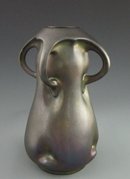Monumental Antique Wasmuël Barbotine Faïence Vase




This tremendous barbotine glazed pottery vase, attributed to the earthenware pottery (barbotine) faïencerie factory of Wasmuël Belgium, circa 1885-1890, sgraffito incised floral and organic designs, the portrait of a maiden, exotic birds and applied ears in the Japanese style, characteristic of the Aesthetic Movement of the late nineteenth century, and known as the "Incruste" decor at Wasmuël. It measures 38" high and 18" wide (96.5 and 45.7 cm). We have not found any hallmarks. Other possible makers include Burmantofts of Yorkshire England, or possibly a competitor influenced by Della Robbia or Burmantofts. The condition is excellent, with no visible signs of repair or restoration, and no vislble chips or cracks. There is a small area of white house paint roughly 1/2" across on the neck which can be removed. The Wasmuël factory was founded by Isidore Paulus, former director of the factory in Onnaing, France, in 1834. In 1878, Auguste Mouzin assumed ownership of the factory and turned its attention toward objects of fantasy and monumental pieces such as this vase. In 1893, France increased customs duties and the export of ornamental pieces became difficult, production would turn to the manufacture of tableware. Eugène Meyer, son-in-law of Auguste Mouzin,succeeded him after his death in 1899. He continued to enlarge the factory to increase the production of crockery, without neglecting the making of decorative pieces and of majolica. His son Henry took over the site in 1907 after the death of Eugène Meyer. Henry Meyer was director of earthenware for more than 40 years, crossing the Art Nouveau and Art Deco periods, and was awarded the Légion d'Honneur at the PARIS exhibition In 1937. The pottery ceased operations in 1952.




